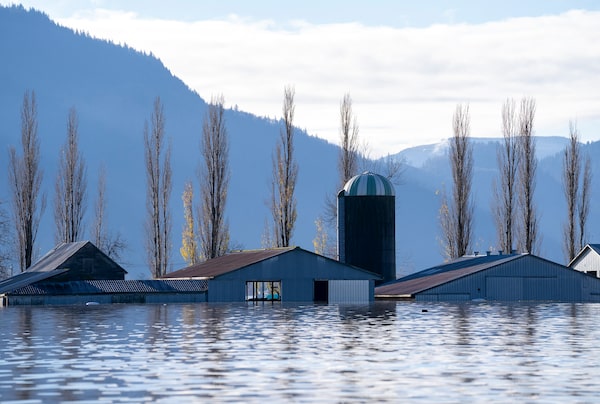
A farm submerged by flood waters caused by heavy rains and mudslides earlier in the week is pictured in Sumas Prairie near Chilliwack, B.C., Nov. 19.JONATHAN HAYWARD/The Canadian Press
Insurers are facing horrendous losses related to this week’s catastrophic flooding in British Columbia, just months after the province suffered devastating fires, highlighting the rising financial risks related to climate change.
Investors so far appear to have faith in the insurance sector’s resilience, but will it last?
The share price of Toronto-based Intact Financial Corp. , a property and casualty insurance company that offers the clearest view of investor sentiment in Canada, slumped just 1.5 per cent in Toronto this week and is up more than 10 per cent this year.
U.S.-based insurers, some of which have exposure to Canada, are also performing well, despite the increasing severity of U.S. wildfires, flooding and hurricanes. The S&P 500 Property & Casualty Insurance Sub Industry Index, which includes Allstate Corp. and Chubb Ltd. , is up 11 per cent this year.
None of these moves suggests much concern on the part of investors, even though B.C. flooding could be Canada’s costliest natural disaster. There is good reason for this complacency: Insurers have demonstrated that they can emerge from natural disasters with little more than a short-term hit to their profitability, even when insured losses soar.
“In Canada, there is an upward trend in claims caused by natural events, or what we call extreme events – wildfires, flooding, hail storms etc.,” Marcos Alvarez, head of insurance at DBRS Ltd., the credit rating agency, said in an interview.
“Although losses have become bigger over the past 10 years in dollar amounts, they remain manageable for insurance companies in Canada,” Mr. Alvarez said.
According to DBRS, large weather-related insured losses in Canada rose to more than $2-billion a year, on average, over the 10-year period from 2011 through 2020. That’s an increase of about 230 per cent over the previous decade.
Climate change is a key source of the problem here, potentially adding considerable risk to insurers as warming temperatures create conditions for more severe wildfires, floods and storms.
So far, insurers have been able to handle catastrophic losses, though. The worst year on record was 2016, the year of the wildfires in Fort McMurray, Alta., which caused $4-billion in insured losses. Even then, insurers reported year-end profits.
Intact took a $128-million hit from the Fort McMurray fires, or about a third of the company’s total catastrophe losses for the year. That sent its annual profit tumbling more than 23 per cent from 2015.
Still, the insurer reported a profit of $541-million for the year, and the share price rose 8.4 per cent.
By comparison, the B.C. wildfires this past summer caused $38-million in catastrophe losses for Intact. Yet, in its third-quarter financial results released Nov. 9, Intact reported a three-month profit of $300-million. And its combined ratio – which compares an insurer’s losses and expenses to its earned premiums – was 91.3 per cent. A ratio below 100 per cent means that underwriting is profitable.
“This is a testament to the underwriting strength of this insurer,” Stephen Boland, an analyst at Raymond James, said in a note.
Intact declined to comment for this article, and insurers have not yet reported the extent of their financial exposure to the B.C. flooding.
Still, the source of Intact’s – and other companies’ – resilience is no mystery. The companies increasingly rely on reinsurers, which provide insurance for insurers and spread out their own risks by issuing so-called catastrophe bonds to pension funds and other sophisticated investors. Insurers are also diversifying geographically to reduce the impact of an extreme event in any one region.
As well, insurers are improving their underwriting standards with better risk assessment and more sophisticated modelling to account for, say, how extreme heat and wildfires can lead to a greater risk of flooding as soil becomes less absorbent.
“These are things that, historically, models have not incorporated but will obviously need to going forward,” Robin Edger, national director of climate change at the Insurance Bureau of Canada, said in an interview.
The question, then, is whether insurers’ resilience will continue as more effects of climate change emerge.
Michael Young, vice-president of model product management at Risk Management Solutions Inc., a catastrophe risk modelling and analytics company, said that the development of risk transfer mechanisms has reduced the risk of insolvency in peak hurricane zones, such as Florida – a promising sign of success.
But insurers can’t be complacent.
“What primary insurance companies do need to worry about, is how fast is climate change affecting their business,” Mr. Young said in an e-mail. Their approaches for setting rates based on historical losses, he warned, must adapt to rapid change.
Be smart with your money. Get the latest investing insights delivered right to your inbox three times a week, with the Globe Investor newsletter. Sign up today.
 David Berman
David Berman